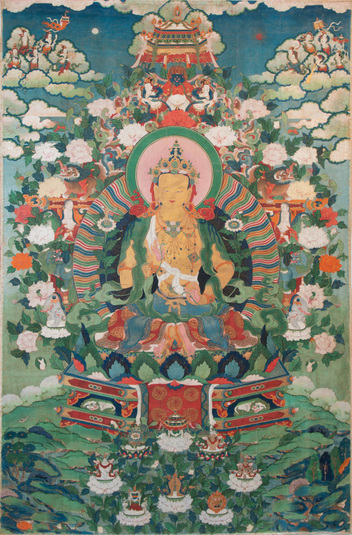
Item: Vajrapani (Bodhisattva & Buddhist Deity)
| Origin Location | China |
|---|---|
| Date Range | 1700 - 1799 |
| Lineages | Buddhist |
| Material | Ground Mineral Pigment on Cotton |
| Collection | Private |
Classification: Deity
Vajrapani, belonging to a set of nine paintings depicting the Eight Great Bodhisattvas along with the central figure of Shakyamuni or Amitabha Buddha. (See Lokeshvara HAR #83827)

In this depiction Vajrapani is golden in colour which is probably the choice of the donor or the artist. In a peaceful guise Vajrapani is often painted green or blue, but there are no iconographic rules for depicting the bodhisattva figures of the Mahayana sutras. There are however certain conventions that have been adopted over time that can also vary from region to region. For Vajrapani the only way to identify him is if he is holding or has a vajra scepter close at hand. In this composition he holds the stems of two flowers blossoming at the shoulders. On the flower at his proper right side there is a vajra standing upright balanced at the center of the blossom. The two hands are in a relaxed gesture in vague imitation of the Dharma Teaching mudra. He wears lavish jewelery and heavenly garments of different colours and patterns. The legs are placed in a posture of ease with the two ankles crossed. A coloured halo and rainbow nimbus surround the body.
Seated on a decorative throne platform an elaborate torana, throne back, extends to the sides and upward. The word 'torana' is from the Sanskrit language and is used commonly as the term to describe the stylized decorative framework surrounding sculptural and painted figures in Indian art specifically and Asian art in general. A torana can be described as a gate, gateway, arch, throne-back, backrest, or decorative niche surrounding a deity, god, buddha, bodhisattva or religious hierarch, teacher or saint.
The torana here is known as the ‘Six Ornaments’ and follows a late Tibetan style popularized in the 17th century. The ornaments refers to the figures of an elephant, lion, sharabha, a boy, makara, naga and topped with a garuda. An elaborate and decorative canopy is placed at the very top.
Symbolically the 'six ornaments' have many meanings such "as the seven things to be eliminated on the path, the six perfections, the four gathering things, the strength of the ten powers, the stainless and the clear light." (Gateway to the Temple by Thubten Legshay Gyatsho. 1971, 1979. page 46).
At the top of the composition are clouds supporting heavely musicians and offereing gods and goddesses. In the foreground are the Eight Auspicious Symbols each standing upright on a lotus blossom surrounded by a verdant landscape.
Jeff Watt 6-2018
Painting Style: Chengde (China)
Collection: Kapoor Galleries
Buddhist Deity: Vajrapani, Bodhisattva (Non-iconic Figures)
Buddhist Deity: Vajrapani Main Page
Collection of Anna Maria Rossi & Fabio Rossi
Buddhist Deity: Vajrapani, Peaceful, Main Page
Collection: Christies New York, March, 2023 (Painting)
Buddhist Deity: Vajrapani Masterworks (Paintings, Peaceful)

